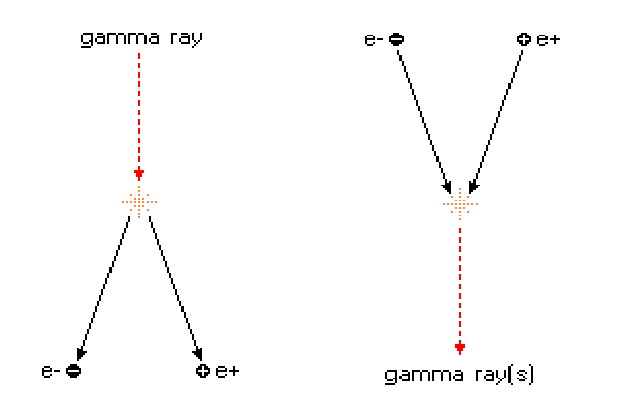In particle physics, antimatter is the extension of the concept of the antiparticle to matter, where antimatter is composed of antiparticles in the same way that normal matter is composed of particles. For example, an antielectron (also called "positron") and an antiproton could form an antihydrogen atom in the same way that an electron and a proton form a normal matter hydrogen atom. Furthermore, mixing matter and antimatter can lead to the annihilation of both in the same way that mixing antiparticles and particles does, thus giving rise to high-energy photons (gamma rays) or other particle – antiparticle pairs.
Every particle of matter has an antimatter equivalent, opposite in charge but with the same mas. If a particle of matter meets it's antimatter equivalent, both are annihilated and a photon, or maybe seral are produced. Conversely a matter – antimatter pair of particles can be produced by the decay of a photon. For this to happen the energy of the photon must be at least equal to![]() where
where![]() is the mass of one of the matter – antimatter pair. The difference between the initial photon energy and
is the mass of one of the matter – antimatter pair. The difference between the initial photon energy and![]() goes into the kinetic energy of the particles. The normal rules of conservation of energy and momentum apply during these processes.
goes into the kinetic energy of the particles. The normal rules of conservation of energy and momentum apply during these processes.

In the diagram above left, a gamma ray decays into an electron and it's antiparticle, the positron. The energy of the gamma ray is at least![]() Any excess of the gamma ray energy over this may go into the kinetic energy of the electron and proton.
Any excess of the gamma ray energy over this may go into the kinetic energy of the electron and proton.
In the diagram above right, an electron and it's antiparticle, the positron meet and annihilate. A gamma ray photon is produced. The energy of the gamma ray is at least![]() Any excess of the gamma ray energy over this is due to kinetic energy of the electron and proton.
Any excess of the gamma ray energy over this is due to kinetic energy of the electron and proton.
